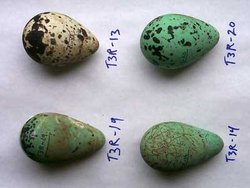Egg (biology)
|
|
Tortoise-Hatchling.JPG
In some animals, an egg is the zygote, resulting from fertilization of the ovum. It nourishes and protects the embryo. Oviparous animals are animals that lay eggs, with little or no other development within the mother. This is the reproductive way of many fish, amphibians and reptiles, all birds, the monotremes mammals, and most insects and arachnids.
Reptile eggs, bird eggs, and monotreme eggs are surrounded by a protective shell, either flexible or inflexible. The 1.5 kg Ostrich egg is the largest existing single cell currently known, though the extinct Aepyornis and some dinosaurs had larger eggs. The Bee Hummingbird produces the smallest known bird egg, which weighs half of a gram. The eggs laid by some reptiles and most fish are even smaller, and those of insects and other invertebrates are much smaller still.
The study or collecting of eggs, in particular bird eggs, is called oology.
| Contents |
Bird eggs
After fertilization, the bird egg is laid by the female and is incubated for a time that varies according to the species; then a single young hatches from each egg. Average clutch sizes range from 1 (as in condors) to about 17 (the Grey Partridge).
Colors
Different animals produce different colored eggs. The pigments protoporphyrin, biliverdin, and zinc chelate of biliverdin, are responsible for the diversity of egg color in birds. These pigments are secreted by cells in the oviduct wall, and can cause speckles if color is added right before the egg is laid. The eggs of modern reptiles are all white, and it is thought that this was true for all animals long ago.
The markings of many birds' eggs may provide camouflage. Cavity-nesting birds such as woodpeckers and kingfishers do not need camouflaged eggs. Their eggs are often bright white, making it easy for the parent to locate them.
In species such as the Common Guillemot, which nest in large groups, each female's eggs have very different markings, making it easier for females to identify their own egg.
Shell structure
Eggs are usually smooth, but there are exceptions. A cormorant's egg, for example, is quite rough and is very chalky. In contrast, tinamous have very shiny eggs, and ducks have oily and waterproof eggs. Another variation is the very heavily pitted eggs of cassowaries.
There are tiny pores in the shells of eggs to allow the unborn animal to breathe. The domestic hen's egg has around 7500 pores.
Shape
Most bird eggs have a characteristic oval shape, with one end rounded and the other more pointy. This shape results from the egg being forced through the oviduct. Muscles contract the oviduct behind the egg, pushing it forward. The egg's wall is still shapeable, and the pointy end develops at the back side.
Predation
Eggfig2.jpg
There are numerous animals that feed on eggs. Principal predators of the Black Oystercatcher's eggs, for example, include raccoons, skunks, mink, river and sea otters, gulls, crows and foxes. The Stoat (Mustela erminea) and Long-tailed Weasel (M. frenata) steal ducks' eggs. The egg-eating snakes (genera Dasypeltis and Elachistodon) specialize in eating eggs.
See also
- Oology - the study or collecting of eggs.
- Nest
- Incubate
- Chicken sexer
- Egg yolk
- Egg whiteca:Ou (biologia)
cs:Vejce de:Ei (Biologie) es:Huevo (biología) fr:Œuf (biologie) he:ביצה (ביולוגיה) lt:Kiaušinis nl:Ei (dier) pl:Jajo pt:Ovo fi:Muna


